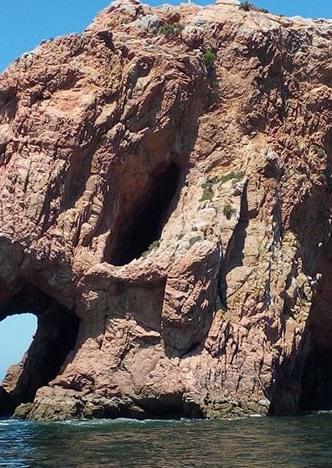Located opposite Peniche, the Archipelago consists of 3 groups of small islands: Berlenga Grande (the only inhabited one, that can be visited by boat from Peniche) and the nearby reefs, Estelas and Farilhões-Forcadas; their geological nature is different from that of the Portuguese coast.
The Islands have their particular fauna and flora, with characteristics that make their ecosystem unique in the world, the importance of which was recognised by the creation of the Berlenga Nature Reserve in 1981.
Parede de Rabo de Asno
Sea caves are habitats of great ecological and geological value. This habitat is very specific and important in terms of marine productivity, providing a refuge for several species of fish that use the area as a nursery (such as the Conger - Conger conger) and for many marine invertebrates. In Berlengas archipelago there are several sea caves very interesting for marine biodiversity. Because of the frail light that penetrates the caves there are few algae and plants however, sea caves are authentic wildlife refuges, with many species of invertebrates (sea fans) and tunicates covering the stony walls. The unique beauty of these caves attracts many scuba divers.
“Parede de Rabo de Asno” is the dive that everybody wants to do (its name translated into English: Donkeys Tail Wall).
The rock is famous for its wall covered with red Gorgonians and for its cave. Its bright blue waters make the wall similar to a coral wall as we usually find in the tropical seas. In certain parts, the density of the Gorgonias covers the rock completely; inside the cave, we can still find walls lined with Gorgonians and the shoals of Pouts sometimes cover the sight. A beautiful sight!
It is a dive with usual currents which brings pelagics to feed along the wall. In the extremities of the rock, there are usually Seabream. It is also possible to see Mola Mola.
Location: Berlengas
Dive Type: Recreational
Dive Site: Sea
What you will see: Sandy bottom, Sea Life, Wreck
Average Depth: 28mts
Maximum Depth: 30mts
Water Temperature: 16ºC-20ºC
Flandres
A very easy and relaxed dive in Berlengas Island. You star the dive on a shallow sandy bottom where you can find some Streaked gurnard (Trigloporus lastoviza) and from there you go to a small cavern where you can usally find some forkbeards (Phycis phycis). You will also visit a small wreck where octopus are common and you can see througout the dive schools the seam breams and cow breams.
Maximum Depth: 15 meters
Quebradas
On the northwest side of Berlenga, this is a place that can only be practiced on days when the sea is calm and without wind. Very wild site with very abrupt canyons and rich in schools of sea bream in the "white water". Visibilities are often 15 meters +.
Maximum Depth: 16 meters
Primavera
This wreck is the easiest one in the Berlengas. Its protected localization allows us to dive there when other places can not be done. Although badly wrecked the Primavera still gives the magic of diving in a wreck. There we can find also Fork-beard, Redfish, Wrasse and Lobsters. John Dory and Sunfish can also be seen.
Maximum Depth: 24 meters
Baía do Cerro do Cão
This bay is in the northern part of the Berlenga, contiguous to a rock that has the silhouette of a lying dog. It is a bay cut by canyons, always parallel to the rock and one dives from one canyon to the next. It has very interesting passages where for times we find ourselves underneath arches. In the beaten walls next to the Berlenga it has always lots of fish and it is frequent to see shoals of small pelagics in the mid water.
Maximum Depth: 25 meters
Vapor do Trigo - Andreos
The Andreos is another sheltered spot, close to the Berlenga, that can be done even with hard seas. The most interesting area is around the boilers, inhabited for great residents but the structure has also many interesting holes to explore. It has usually great pink Sea-bream that swim isolated or in small shoals. For moreover, as it is in an area of current confluence is usual to see Sunfish here.
Maximum Depth: 26 meters
Rinchão
This reef is located north of the Berlenga. Dangerous for the navigation, it is a fantastic spot for diving. The head sometimes appears out of the water, in great tides, and it has a slope where the water goes up and the fish feeds that goes down until 30 meters. The amount of fish is frequently amazing, Sea-bream, Cow-bream, Sea-bass, Amberjacks and Trigger-fish are frequent. In the deeper part it has walls covered of red gorgonia (Paramuricea Clavata) and one wreck, Gomes VIII, of which we can see the boiler, bits of the engine and still some structure. It is an exposed dive with frequent currents.
Maximum Depth: 32 meters
Parede Rinchoa
As the name indicates this wall is close to the Rinchão. It consists of a reef head that starts at 13 meters with a wall until 35. The wall faces north and is forrowed with the typical red Gorgonia (Paramuricea clavata). It has small caves also inhabited for great Conger and is an area where one can sight Great Sea-Bass in the deep and Amberjacks in the higher parts.
Maximum Depth: 35 meters



